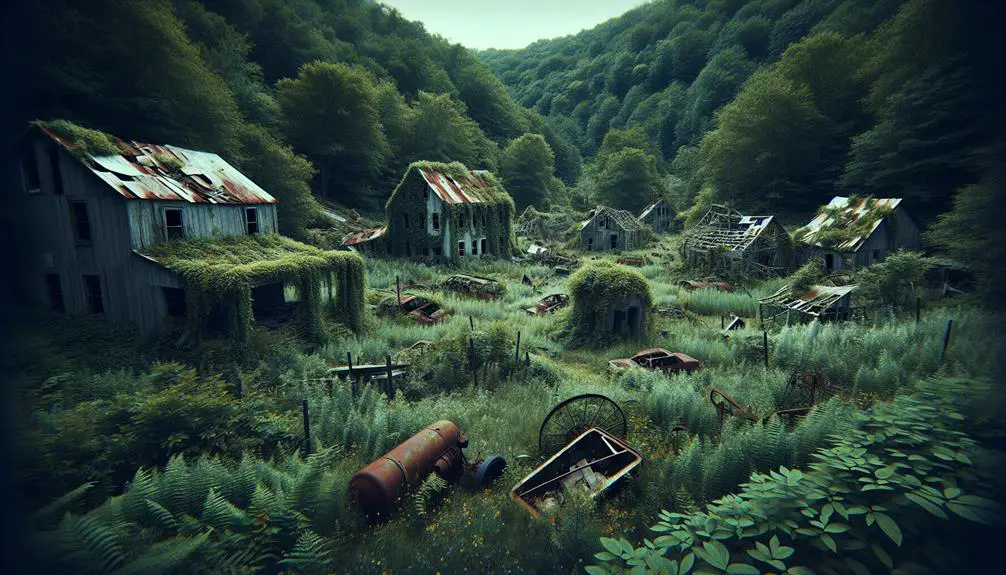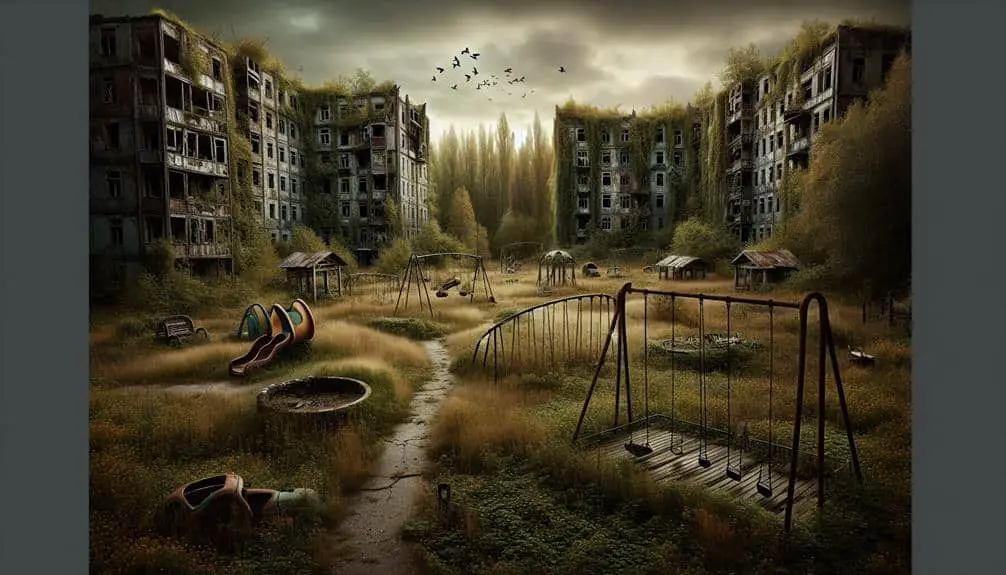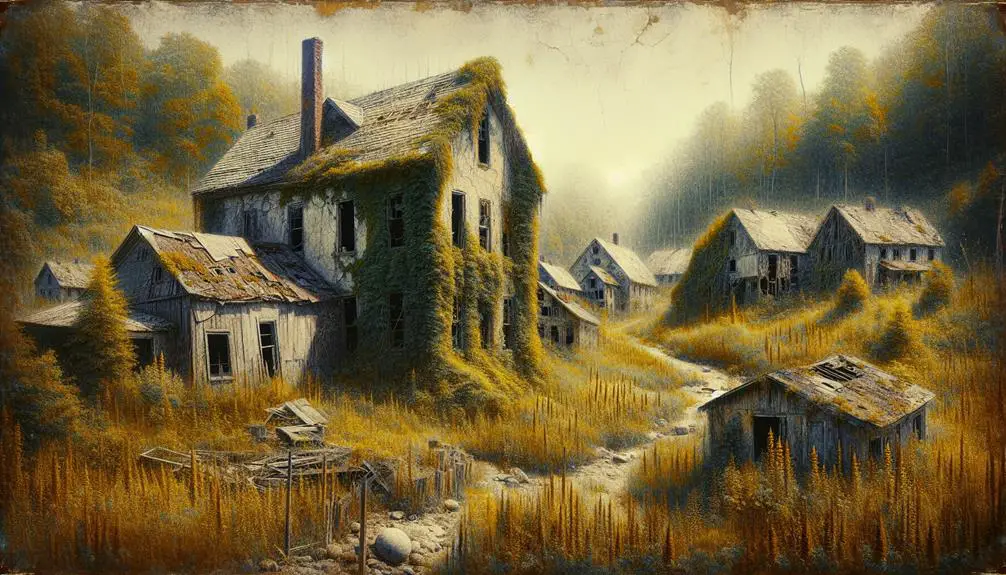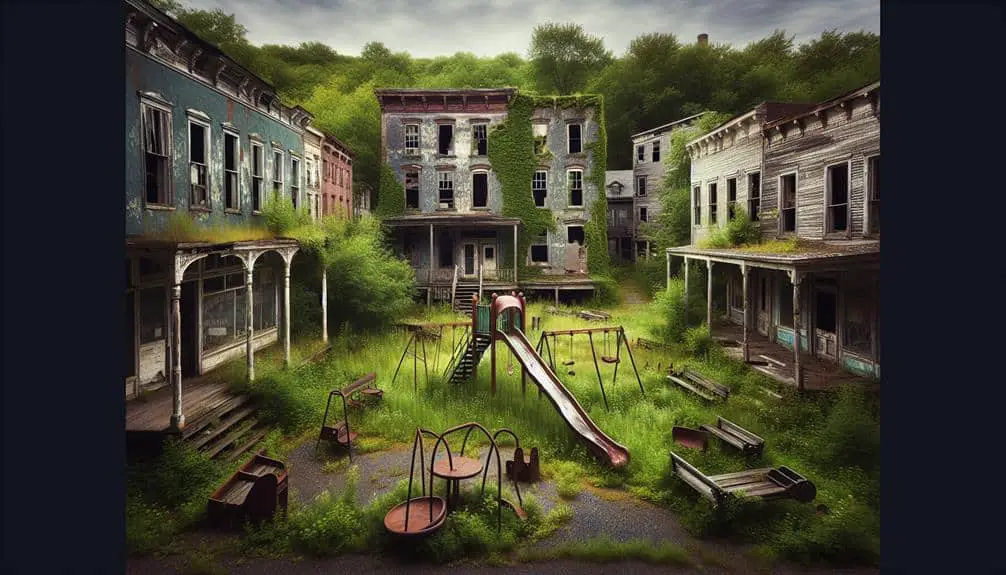Discover the haunting remnants of failed US utopian communities and ghost towns. Abandoned structures reveal grand visions overtaken by human complexities. Internal conflicts within communal dynamics often led to downfall. Decaying walls whisper tales of hopes crushed by realities. Unravel the ghostly encounters and forgotten spirits haunting desolate spaces. Witness the echoes of lives interrupted and dreams unfulfilled. These remnants offer a glimpse into the fragile balance between utopian ideals and harsh truths.
Key Points
- Abandoned structures reveal aspirations and struggles of failed utopian communities.
- Haunting stories of past residents linger in desolate spaces of ghost towns.
- Preservation efforts revive failed utopian sites for historical and tourism significance.
- Failed utopian communities serve as lessons on community dynamics and planning.
- Decaying structures and artifacts reflect the fragility of utopian visions and human resilience.
Origins of Failed Utopian Settlements
The origins of failed utopian settlements can often be traced back to a combination of idealistic fervor and practical challenges that were underestimated by the founders. In the pursuit of founder ideologies focused on creating an idyllic society, conflicts within the societal structure often arose as a significant hindrance. The clash between idealistic visions and the complexities of human nature frequently led to internal divisions and power struggles, eroding the very foundation on which these utopian communities were built.
Founder ideologies, while noble in intention, sometimes failed to account for the inherent diversity of human thoughts, beliefs, and behaviors. This oversight often fueled societal conflicts, causing rifts that widened over time and ultimately contributed to the downfall of the utopian experiment. As utopian settlements grappled with the challenge of harmonizing individual freedoms with collective ideals, tensions simmered beneath the surface, eventually erupting into irreconcilable differences that shattered the communal dream into fragments of disillusionment.
Abandoned Structures and Artifacts
Often overlooked but integral to understanding the history of failed utopian communities are the abandoned structures and artifacts left behind, offering tangible glimpses into the aspirations and struggles of those who once inhabited these now deserted places. These remnants serve as windows into a bygone era, where visions of a perfect society once flourished but ultimately faltered.
Lost treasures, such as weathered journals and faded blueprints, reveal the grand plans that never came to fruition. Hidden secrets lie within the cracked walls of abandoned buildings, whispering stories of both hope and despair. Each decaying structure tells a silent tale of human ambition and the harsh realities of communal living.
The remnants of failed utopian settlements stand as poignant reminders of the complexities of human nature and the challenges of realizing idealistic dreams. As you explore these abandoned sites, you unearth fragments of the past that shed light on the fragility of utopian visions and the resilience of the human spirit in the face of adversity.
Haunting Stories of Past Residents
Investigating the abandoned structures and artifacts of failed utopian communities exposes haunting stories of past residents, illuminating the human experiences that once occupied these now desolate spaces. Within these ghost towns lie tales of ghostly encounters and forgotten spirits, lingering remnants of lives interrupted. The spectral presence of these former inhabitants can be felt in the silence that envelops the crumbling buildings and empty streets, whispering of dreams unfulfilled and aspirations left unrealized.
Each dilapidated structure holds echoes of the past, offering glimpses into the lives of those who once called these places home. From the decaying remnants of communal gathering spaces to the overgrown gardens that were once tended with care, the spirits of the past seem to linger in every corner, their presence palpable to those who dare to listen.
These haunting stories serve as a reminder of the human cost of failed utopian visions, a confirmation to the resilience and fragility of the communities that once thrived in these now deserted landscapes.
Revival Attempts and Preservation Efforts
Attempts to revive and preserve the remnants of failed utopian communities have garnered varied success rates, reflecting both the challenges and significance of salvaging these historical sites. Engaging in restoration projects and fostering community involvement are pivotal in breathing new life into these once-thriving but now abandoned areas.
Here are three key aspects to keep in mind:
- Community-Led Initiatives: Restoration projects initiated and led by local communities often yield the most successful results. When residents take ownership of preserving their heritage, there's a heightened sense of commitment and passion that drives these efforts forward.
- Historical Significance: Recognizing the historical importance of these failed utopian communities is essential in attracting visitors and generating tourism potential. By highlighting the unique stories and ideals behind these settlements, a new narrative can emerge, making them not just ghost towns but living museums of a bygone era.
- Sustainable Preservation: Ensuring the long-term preservation of these sites requires sustainable practices and ongoing support. Balancing the need for conservation with the desire for economic development is vital in maintaining the integrity and authenticity of these historical landmarks.
Lessons Learned From Utopian Failures
Drawing insights from the failures of utopian communities provides valuable lessons for understanding the complexities of communal living and societal experimentation. When examining these failures, one key lesson that emerges is the critical role of community dynamics. Utopian communities often struggled due to internal conflicts, power struggles, and the inability to sustain a cohesive vision among members. Understanding how to navigate and nurture healthy community dynamics is essential for the success of any communal endeavor.
Additionally, failed utopian experiments shed light on the challenges of societal experiments. These failures highlight the importance of realistic planning, adaptability, and the need for continuous evaluation and adjustment. Utopian visions must be grounded in practicality and a deep understanding of human behavior and social structures to have a chance at success.
Frequently Asked Questions
Were There Any Paranormal Experiences Reported by Visitors to These Ghost Towns?
When exploring ghost towns, you might encounter urban legends and paranormal encounters. Supernatural happenings and ghostly sightings are often reported by visitors, adding an eerie allure to these abandoned places steeped in history and mystery.
What Impact Did the Failed Utopian Communities Have on the Surrounding Environment?
As failed utopian communities dissolved, environmental degradation followed. The once vibrant lands succumbed to neglect, echoing the communities' displacement. Nature bore witness to the aftermath, a stark reminder of human aspirations turned awry.
Are There Any Lost Treasures or Hidden Secrets Rumored to Be Buried in These Abandoned Settlements?
Explore abandoned settlements for hidden treasures and lost secrets. Urban legends and mysterious rumors swirl around these ghost towns. Uncover the enigmatic past and potentially discover forgotten riches waiting to be found.
Have Any Famous Figures or Historical Events Been Associated With These Ghost Towns?
Have famous figures left their mark on these ghost towns? Historical connections reveal the influence of prominent individuals and events, shaping the narrative of these abandoned settlements. Can you uncover the stories hidden within?
How Do Modern Communities Near These Failed Utopian Settlements View Their History and Legacy?
You might find that modern communities near these failed utopian settlements have varied perceptions of their history and legacy. Some cherish the cultural heritage, while others feel the economic impact still lingers.



